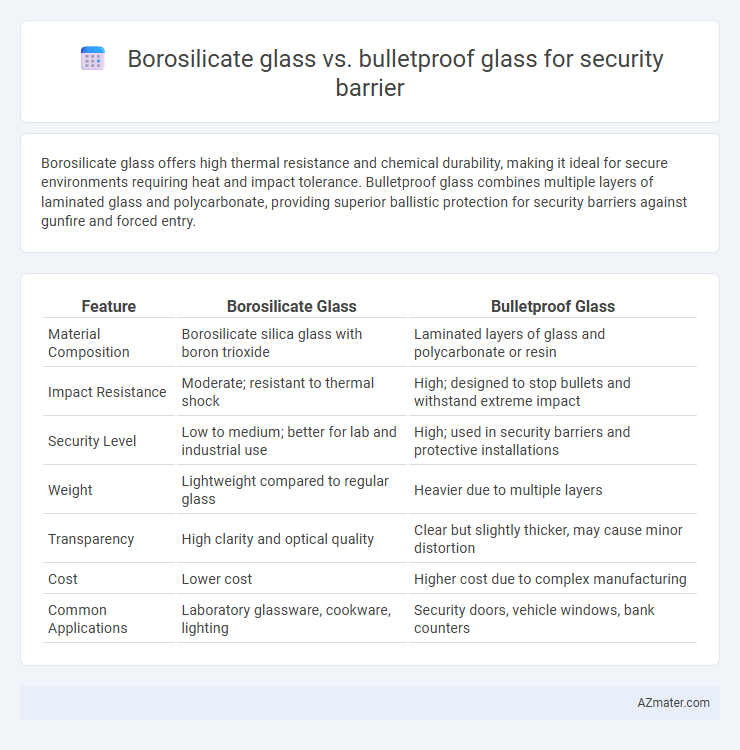Borosilicate glass offers high thermal resistance and chemical durability, making it ideal for secure environments requiring heat and impact tolerance. Bulletproof glass combines multiple layers of laminated glass and polycarbonate, providing superior ballistic protection for security barriers against gunfire and forced entry.
Table of Comparison
| Feature | Borosilicate Glass | Bulletproof Glass |
|---|---|---|
| Material Composition | Borosilicate silica glass with boron trioxide | Laminated layers of glass and polycarbonate or resin |
| Impact Resistance | Moderate; resistant to thermal shock | High; designed to stop bullets and withstand extreme impact |
| Security Level | Low to medium; better for lab and industrial use | High; used in security barriers and protective installations |
| Weight | Lightweight compared to regular glass | Heavier due to multiple layers |
| Transparency | High clarity and optical quality | Clear but slightly thicker, may cause minor distortion |
| Cost | Lower cost | Higher cost due to complex manufacturing |
| Common Applications | Laboratory glassware, cookware, lighting | Security doors, vehicle windows, bank counters |
Introduction to Security Barriers
Security barriers are essential for protecting premises against unauthorized access and potential threats. Borosilicate glass offers high thermal resistance and chemical durability but has moderate impact resistance, making it suitable for environments requiring visibility and chemical stability. Bulletproof glass, composed of multiple polycarbonate and glass layers, provides superior ballistic protection and is ideal for high-security applications where resistance to firearm attacks is critical.
What is Borosilicate Glass?
Borosilicate glass is a type of glass known for its exceptional thermal resistance and durability, making it highly suitable for security barriers that require strength and heat tolerance. Unlike bulletproof glass, which is typically laminated with multiple layers of polycarbonate and glass to absorb and disperse impact energy, borosilicate glass offers enhanced chemical stability and resistance to thermal shock. Its composition, primarily silica and boron trioxide, allows it to maintain structural integrity under extreme conditions, though it may not provide the same level of ballistic protection as dedicated bulletproof materials.
What is Bulletproof Glass?
Bulletproof glass is a multi-layered composite made from laminated glass and polycarbonate materials designed to withstand high-velocity ballistic impacts. It is engineered to absorb and disperse the energy from bullets, preventing penetration and providing robust security barriers in sensitive environments. Unlike borosilicate glass, which offers excellent thermal resistance and durability, bulletproof glass prioritizes impact resistance and safety against firearm threats.
Material Composition: Borosilicate vs Bulletproof Glass
Borosilicate glass is composed primarily of silica and boron trioxide, which provides high thermal resistance and chemical durability, making it ideal for laboratory and industrial use but less effective against high-impact forces. Bulletproof glass, also known as ballistic glass, is typically a laminated composite made from multiple layers of glass and polycarbonate or other plastic materials, engineered to absorb and disperse the energy of bullets and prevent penetration. The fundamental difference in material composition results in borosilicate glass offering superior heat resistance while bulletproof glass provides enhanced impact resistance and security protection in barrier applications.
Impact Resistance and Protection Levels
Borosilicate glass offers moderate impact resistance due to its thermal shock stability and chemical durability, making it suitable for certain security barriers but less effective against high-velocity projectiles. Bulletproof glass, composed of layered polycarbonate and laminated glass, provides superior protection levels, capable of stopping bullets and withstanding significant impact forces. For critical security applications demanding maximum impact resistance and protection, bulletproof glass remains the preferred material over borosilicate glass.
Durability and Longevity Comparison
Borosilicate glass offers excellent thermal and chemical resistance, ensuring long-term durability in security barriers exposed to harsh environmental conditions. Bulletproof glass, composed of multiple laminated layers of polycarbonate and glass, provides superior impact resistance, making it ideal for high-risk security applications requiring maximum protection against ballistic threats. While borosilicate glass excels in scratch resistance and longevity under normal wear, bulletproof glass offers enhanced durability against physical attacks but may require maintenance or replacement after severe impacts.
Clarity and Visibility Factors
Borosilicate glass offers superior optical clarity with minimal distortion, ensuring maximum visibility essential for security barriers in environments requiring clear sightlines. Bulletproof glass, while providing enhanced protection and impact resistance through multi-layered laminated construction, often sacrifices some transparency due to thickness and interlayers, potentially causing slight visual distortion. Choosing between the two depends on balancing the need for high visibility with the required security level, as borosilicate glass excels in clarity, whereas bulletproof glass prioritizes safety.
Cost Analysis: Borosilicate vs Bulletproof Glass
Borosilicate glass generally offers a lower initial cost compared to bulletproof glass, making it a budget-friendly option for security barriers with moderate protection needs. Bulletproof glass, composed of multiple layers of laminated polycarbonate and glass, incurs higher manufacturing and installation expenses but provides superior resistance against ballistic threats. When analyzing long-term cost-effectiveness, bulletproof glass can reduce replacement frequency and maintenance costs due to its durability under high-impact conditions.
Common Applications in Security Barriers
Borosilicate glass, known for its high thermal resistance and durability, is commonly used in laboratory security barriers and protective enclosures where chemical resistance and visibility are crucial. Bulletproof glass, typically layered with polycarbonate or acrylic, is extensively employed in bank teller windows, armored vehicles, and secure building entry points to provide ballistic protection against firearms. Both materials serve distinct security applications, with borosilicate glass favored for environments requiring resilience to impact and heat, while bulletproof glass is prioritized for high-threat scenarios demanding multi-hit ballistic resistance.
Choosing the Right Glass for Security Needs
Borosilicate glass offers exceptional thermal resistance and durability, making it ideal for applications where high temperature tolerance and chemical stability are crucial. Bulletproof glass, typically composed of layered polycarbonate and glass, provides superior impact resistance and ballistic protection essential for security barriers exposed to potential threats. Selecting the right glass depends on assessing threat levels, with bulletproof glass preferred for high-risk environments requiring advanced defense, while borosilicate glass suits safer areas needing durability and heat resistance.

Infographic: Borosilicate glass vs Bulletproof glass for Security barrier
 azmater.com
azmater.com